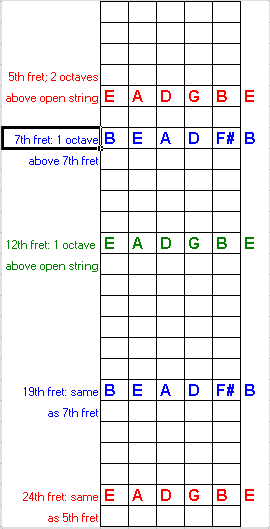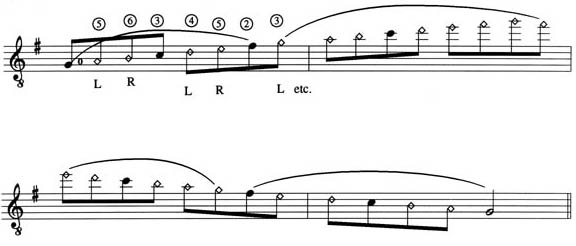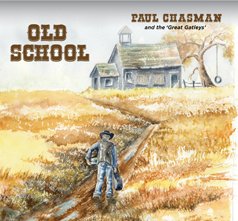Harmonics - November 22, 1999
 Harmonics,
those bell like tones that are created by touching a string rather
than fretting it, can add a new, otherworldly dimension to your
guitar playing. Historically, harmonics have been used primarily
for effect, for punctuation or miscellaneous tricks. I would
like to offer a basic foundation, and then begin to explore my
system which I started developing some fifteen years ago as an
attempt to raise the level of harmonics playing from dings and
dongs, to a means of integrating them into a whole method of
playing the guitar. Harmonics,
those bell like tones that are created by touching a string rather
than fretting it, can add a new, otherworldly dimension to your
guitar playing. Historically, harmonics have been used primarily
for effect, for punctuation or miscellaneous tricks. I would
like to offer a basic foundation, and then begin to explore my
system which I started developing some fifteen years ago as an
attempt to raise the level of harmonics playing from dings and
dongs, to a means of integrating them into a whole method of
playing the guitar.
The twelfth fret is the octave, and the half-way point between the nut and the bridge. If you touch a string without pressure over the 12th fret line itself (not between frets, as you would if you were pressing down), then pluck the string, you should get a harmonic note that is the same pitch as the fretted note. For example, if you touch the high E string at the 12th fret and pluck it, you should get an E harmonic, one octave higher than the open string. If you are new to this, you may need to experiment to find just the right touch to get the harmonic sound. The harmonics at the 12th fret then, are: E, A, D, G, B, E, one octave above open. If you use the same technique at the 7th fret, you will get harmonics one octave above the fretted notes at that spot. These notes will be: B, E, A, D, F#, B, one octave above the 7th fret. The 19th fret will give you exactly the same harmonics as the 7th fret. The reason for this is that the 19th fret is the same distance to the bridge as the 7th fret is to the nut, and your guitar doesn't know the difference! I think of the 19th fret as the 7th fret above 12. (Are you still with me?) Harmonics can also be found at the 5th fret. These will be E, A, D, G, B, E, two octaves above open, or one octave above the 12th fret harmonics. We find the same phenomenon of duplicate harmonics at the equivalent of the 24th fret, which should be about 1/4 of the way down your sound hole. (I have the benefit of a 24 fret extension on my Elliott classical and my Ehlers steel string, which make it easy to find those notes.) The 24th fret is the same distance to the bridge as the 5th fret is to the nut, so both places will give you E, A, D, G, B, E harmonics, two octaves above open. The harmonics I have been talking about are natural harmonics. These are the places on the guitar where harmonics most naturally occur. An overview of your natural harmonics looks like this: EX: #1 As you may have noticed, the natural harmonics do not include all the notes in the chromatic scale. To access the notes that the guitar doesn't automatically give you (artificial harmonics), you must first learn to cover the harmonic and pluck it with the right hand. Bring your right index finger to the 1st string, 12th fret, and point the finger rigidly until it is touching the 12th fret line. While you are touching the string, pluck it with your third finger, and you should once again have an E harmonic. As you did before, you may have to experiment with your touch until you get a good, clear sound. A key to control is to keep the index finger pointing straight and rigid when covering the harmonic. When you are fairly comfortable with this technique, try plucking the string with your thumb rather than your third finger, still covering the harmonic note with your pointed index finger. Both these methods will be necessary before long. Once you are comfortable with the right hand technique, you are ready to play artificial harmonics. With your left hand, cover the 1st string, 1st fret which is F. In the previous exercise, your right hand was at E, on the 12th fret. Bring your right hand up to the 13th fret, touch the fret with your pointed index finger and pluck, while you are holding down the F at the 1st fret. You should now be playing an F harmonic. Want an F#? Come up to the 2nd fret with your left hand, and come up one more fret with your right hand to fret 14, and voila! F# harmonic. The basic principal is that you mirror your left hand with your right, 12 frets above. Show Me A Trick OK, I'll show you a trick. Give your left hand a rest. You won't need it for a bit. With your right hand, come up to the 12th fret and play the harmonic on the E bass string. The notation looks like this: EX: 2 The triangle indicates a harmonic. The circled 6 means 6th string. The R suggests that you cover the harmonic with your right hand (L=left). The small zero means open string. Be sure to pluck the string with your thumb, because you will now play the open G string with your 3rd finger (not the harmonic, just the plain, open G). Now play the A harmonic on the fifth string with your thumb, followed by the open B string, followed by the D harmonic (4th string), followed by the open high E. You have now played a pentatonic scale, which notated, will look like this: EX: 3 Part of the key to making this type of passage work is to "bury" the non-harmonic notes; play them softer, and overemphasize the harmonics, so that you create an illusion that all the notes are harmonics. Also, be sure to allow all notes to sustain, so at the end, all six strings are ringing. Now try this: EX: 4 This was an E pentatonic minor scale. Suppose you want to play an F pentatonic minor. Simply barre the 1st fret, bring your right hand up one fret to the 13th, and repeat the right hand pattern: EX: 5 The above exercises set the stage for my harmonics system. The system is based on scales, which are the building blocks of our musical language. I devised the scales with two goals: 1) To sustain the harmonics for as long as possible. This resulted in my decision to use natural harmonics whenever possible. An artificial harmonic is automatically cut off when the fret is released. A natural harmonic can sustain until you play another note on that string. 2) To maximize speed and fluidity. This required alternate methods of picking, just as a flatpicker can play faster going down-up than with all down strokes. This also required alternating between left hand harmonics and right hand harmonics whenever possible. With these premises in mind, let's try a G scale. Begin by situating the third finger of your left hand at the 12th fret harmonic line. Point your right hand index finger at the 19th fret harmonic line. For much of this octave, you will alternate between a left hand harmonic at the 12th fret, and a right hand harmonic at the 19th fret. To begin, play the G harmonic at the 12th fret (covering it with your left hand, picking it with the 3rd finger of your right). Now play the A harmonic on the fourth string, covering the 19th fret with your pointing index finger, plucking with your thumb. Next, play the B harmonic, 2nd string, 12th fret, covering it with your left hand, picking with the 3rd finger of your right. (Be sure to pick all the left hand harmonics with your 3rd finger, right hand harmonics with your thumb, in order to alternate your picking.) Now comes a C note which cannot be played as a natural harmonic. So, cover the C on the 1st string, 8th fret, and pick it as a regular note. In the context of the scale, you will want to "bury" this note in order to make it blend into the harmonics. Then play the D harmonic with the right hand (3rd string, 19th fret) followed by the E harmonic (12th fret), followed by the F# harmonic (2nd string, 19th fret). You then have the option to jump with the right hand to the G string, 24th fret, or with the left hand to the G string 5th fret for the high G. The advantage to the 5th fret G harmonic is that you can stay in the flow of your left hand-right hand alternation. The advantage of the 24th fret is that I have found that you can get a clearer tone than at the 5th fret. I will notate the 24th fret, but try it both ways. EX: 6 I'll leave you with one more thing to try. This will cover two octaves of the G scale. EX.7 Next column, I will give you a taste of my harmonics arrangement of "Blackbird." Til then... BACK TO ARCHIVES |








